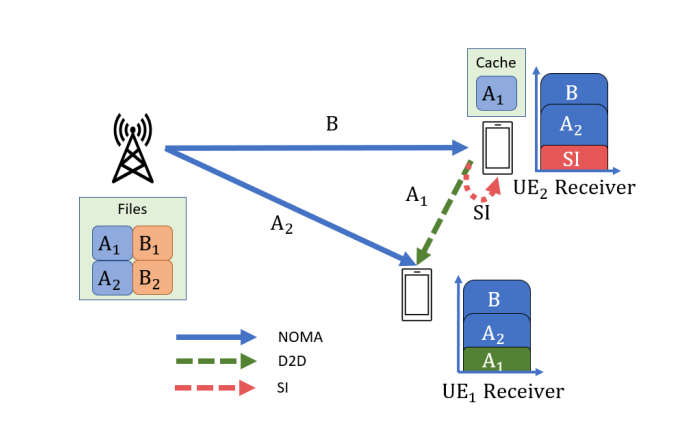
New method helps direct sharing of content without involving a main communications network, reducing congestion and making data transfer faster
A research team led by faculty from Khalifa University of Science and Technology has developed a method where device-to-device (D2D) communications, combined with caching and non-orthogonal multiple access (NOMA) – a multiple access technique used for 5G cellular wireless networks – can reduce mobile network congestion and make data transfer faster, thus revolutionizing mobile data exchange.
The digital age has seen an unprecedented boom in the consumption of multimedia content, with growth in users fueling the demand for faster and more efficient ways to access content. Today, seamless and quick sharing of digital content is expected. As demand surges, however, networks become clogged, resulting in slower downloads and buffering issues.
Research from Khalifa University may offer a potential solution to this issue. If two smartphones in close proximity could directly share a video without using bandwidth on the main network, this could be the next big leap in mobile data exchange. Enter device-to-device (D2D) communications, combined with caching and non-orthogonal multiple access (NOMA).
Prof. Zhiguo Ding, Department of Electrical Engineering and Computer Science at Khalifa University, with Kevin Shen and Daniel So from the University of Manchester, and Jie Tang, South China University of Technology, has developed a method where D2D communications can be used to allow users to share cached content directly with each other. Their work was published in IEEE Transactions on Wireless Communications, a top 1% journal in applied mathematics.
The idea behind caching is straightforward: Store popular or regularly accessed content closer to users. This reduces network congestion and enables faster access. By placing these caches at local access points or even directly on a user’s device, the time taken to fetch a requested file can be drastically reduced. This also reduces the burden on the main network, which can then better handle other tasks. This caching method is now a significant area of focus for researchers aiming to enhance user experience and overall network performance.
NOMA technology goes hand in hand with caching, aiming to increase the efficiency of networks by allowing multiple users to access resources simultaneously. The research team developed a simple power allocation method for D2D communications to maximize efficiency and ensure optimal sharing without making things too complicated. Their model is particularly effective when one user with a stronger network connection has content wanted by a user with a weaker connection. Even when the roles are reversed, their method still outperforms traditional NOMA set ups.
“If the content you want isn’t in your personal device’s cache, there’s a good chance nearby users might have it on theirs,” Prof. Ding explained. “This is where D2D communication becomes a game-changer. Instead of every user individually accessing a central server, D2D allows users to share content directly with each other, bypassing the main network. This not only speeds up access but also further alleviates network congestion.”
The research team’s solution introduces a system where users share partially cached content directly through D2D while the rest comes from NOMA in a power-efficient manner. Even if a device can’t store a full video, for example, it can store parts of it, and with D2D, share those parts directly with another user, making the entire process faster.
As the demand for rapid data sharing continues to grow, technology needs to adapt to meet that demand. While the current model focuses on fixed minimum rate requirements, future research will pivot to flexible rate constraints or minimizing total transmission times based on cached data.
Jade Sterling
Science Writer
18 September 2023






